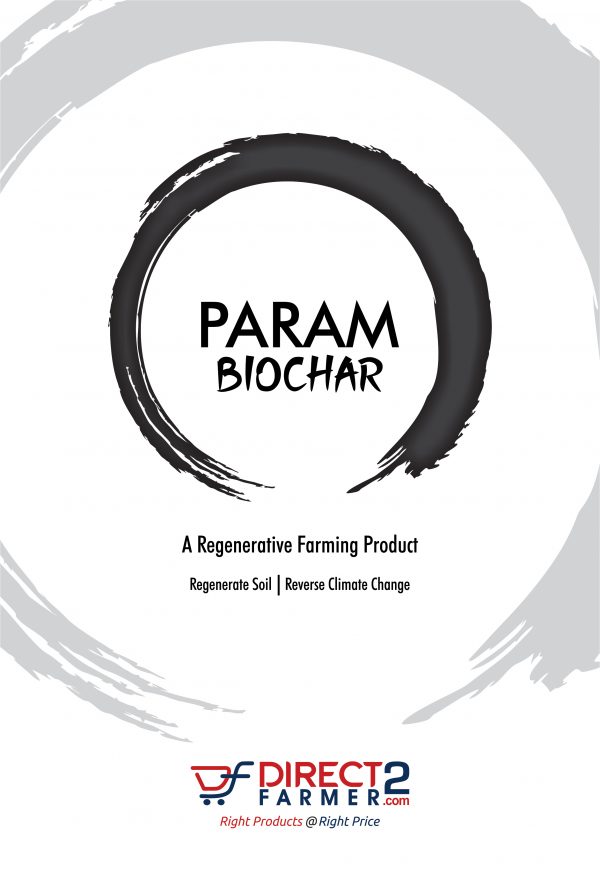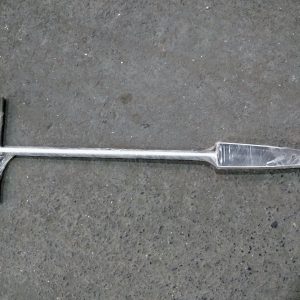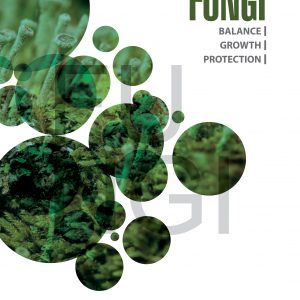Description
Ploughing in the soil 0.5 kg of biochar per m2 increases crop productivity to levels that range from 50 to 200%.
Just one application provides and maintains long-lasting soil fertility benefits that enhance carbon sequestration in the soil, thus fighting climate change.
Today, biochar research shows measurable, replicable improvements in soil productivity :
1. Enhances soil biology (40% increase in mycorrhizal fungi)
2. Improves nutrient retention in soils (50% increase in Cation Exchange Capacity)
3. Improves the water retention capacity of soils (up to 18% increase)
4. Increases the pH of acidic soils (1 point pH increase)
5. Increases soil organic matter

What is biochar?
Biochar is a plant boosting char, also called by some “the black gold for soils” and is the perfect ingredient for the garden all year round. It will enhance plant growth and increase the sustainability of your garden. It is used to improve your soil by storing nutrients, which can then be taken up by the roots, as the plants require.
Soil with nutrient enriched Biochar :
· retains moisture – therefore helps plants survive dry conditions better
· leads to smooth, continuous growth
· strong flowering and fruit set
· increases soil water holding capacity whilst improving drainage
· helps plants resist diseases
· is a nutrient bank – highly adsorbent, reduces nutrient loss by leaching or volatilization, thus increasing
fertilizer efficiency and reducing associated costs
What is the difference between charcoal and biochar?
Biochar is used as a soil amendment, and charcoal is used as a fuel
Charcoal is made by heating wood in the absence or near absence of oxygen (pyrolysis), so that it releases volatile compounds (hydrogen, carbon monoxide, aliphatic and aromatic hydrocarbons) as well as water vapor and soot (basically, what the wood is releasing is a volatile form of smoke). Some of this “smoke” is directed to a place within the process where it is combined with air, and it burns, creating more heat, to drive the process (heating more wood) forward, while some of this “smoke” is fed back into the cooling or cooled, blackened (carbonized) wood, and the carbonized wood absorbs and collects this “smoke” – making the resulting charcoal easier to light, and increasing the energy content (the re-absorbed “smoke” also gives charcoal a characteristic “greasy” feeling against the skin, and the blackness left on the skin will most likely need to be washed off with soap and water).
For biochar production, the “smoke” is used similarly, to drive the process, but none of the “smoke” is directed back into the cooled char – instead, the surplus “smoke” can be piped somewhere else and burned to produce heat for a separate process, or it can be used to fuel an internal combustion engine, or condensed into wood vinegar. Biochar, if rubbed against the skin, should not feel “greasy”, and should not require soap to wash it off – just water should wash most of it off.
What can biochar do?
Sustainable biochar is a powerfully simple tool that can :
· Save Water
· Save Fertilizer
· Grow better Plants (note the root growth of the black currant seedling)
· Soil enrichment
· Optimum drainage
· Makes soil more fertile
· Reduce leaching of nitrogen into ground water
· Provide protection against some foliar and soil-borne diseases
How is biochar produced?
Carbonization is the process of converting a feedstock into biochar through reductive thermal processing. The process involves a combination of time, heat and pressure exposure factors that can vary between processors, equipment, and feedstocks. There are two main processes: pyrolysis or gasification. Energy products in the form of gas or oil are produced along with the biochar. These energy products may be recoverable for another use, or may simply be burned and released as heat. In addition, biochar can be made from a wide variety of biomass feedstocks. As a result, different biochar systems emerge on different scales. These systems may use production technologies that do or do not produce recoverable energy as well as biochar, and range from small household units to large bioenergy power plants.
How can biochar help farmers?
Biochar provides a unique opportunity to improve soil fertility for the long term using locally available materials. Used alone, or in combinations, compost, manure and/or agrochemicals are added at certain rates every year to soils, in order to realize benefits. Application rates of these can be reduced when nutrients are combined with biochar. Biochar remains in the soil, and single applications can provide benefits over many years. Farmers can also receive an energy yield when converting organic residues into biochar by capturing energy given off in the biochar production process. In both industrialized and developing countries, soil loss and degradation is occurring at unprecedented rates, with profound consequences for soil ecosystem properties. In many regions, loss in soil productivity occurs despite intensive use of agrochemicals, concurrent with adverse environmental impacts on soil and water resources. Biochar can play a major role in expanding options for sustainable soil management by improving upon existing best management practices, not only to improve soil productivity but also to decrease nutrient loss through leaching by percolating water.
How does biochar affect soil biology?
Decades of research in Japan and recent studies in the U.S. have shown that biochar stimulates the activity of a variety of agriculturally important soil microorganisms, and can greatly affect the microbiological properties of soils. The pores in biochar provide a suitable habitat for many microorganisms by protecting them from predation and drying while providing many of their diverse carbon (C), energy and mineral nutrient needs. With the interest in using biochar for promoting soil fertility, many scientific studies are being conducted to better understand how this affects the physical and chemical properties of soil and its suitability as a microbial habitat. Since soil organisms provide a myriad of ecosystem services, understanding how adding biochar to soil may affect soil ecology is critical for assuring that soil quality and the integrity of the soil subsystem are maintained.
How does biochar affect soil properties like pH and CEC?
Biochar reduces soil acidity which decreases liming needs, but in most cases does not actually add nutrients in any appreciable amount. Biochar made from manure and bones is the exception; it retains a significant amount of nutrients from its source. Because biochar attracts and holds soil nutrients, it potentially reduces fertilizer requirements. As a result, fertilization costs are minimized and fertilizer (organic or chemical) is retained in the soil for longer. In most agricultural situations worldwide, soil pH (a measure of acidity) is low (a pH below 7 means more acidic soil) and needs to be increased. Biochar retains nutrients in soil directly through the negative charge that develops on its surfaces, and this negative charge can buffer acidity in the soil, as does organic matter in general.
CEC stands for Cation Exchange Capacity, and is one of many factors involved in soil fertility. “Cations” are positively charged ions, in this case we refer specifically to plant nutrients such as calcium (Ca2+), potassium (K+), magnesium (Mg2+) and others. These simple forms are those in which plants take the nutrients up through their roots. Organic matter and some clays in soil hold on to these positively charged nutrients because they have negatively charged sites on their surfaces, and opposite charges attract. The soil can then “exchange” these nutrients with plant roots. If a soil has a low cation exchange capacity, it is not able to retain such nutrients well, and the nutrients are often washed out with water.
What is fixed carbon and how much is there in Biochar ?
A high fixed Carbon content is an indication of recalcitrance of the biochar. This simply means that the biochar has resistance to faster degradation and will remain in the soil for a longer time which is exactly what you want. Our Biochar has approx 80% fixed carbon.
How often should you apply ?
Regularly when sowing seeds, when transplanting seedlings, when under-sowing pastures, or when side-dressing crops.
How? Where to apply ?
1. Layered or mixed with composts and or animal manures / urine to produce nutrientand microbial-enriched and ‘aged’ biochar.
2. Combined with NPK fertilizers, limestone or ash, or “fertichar”
– Nutrients adsorbed onto biochar surfaces reduce leachate losses, and acts like a slow release fertiliser
3. In seed trays, seed-balls, or potting media prior to transplanting.
4. No-tillage methods or “banded” adjacent to ‘Root-Zone’ soils and ‘Mycorrhiza-zone’ soils.
– Root zone (“rhizosphere”) application concentrates biochar around the root zone and soil microbial communities reduces costs and maximises effects of biochar per plant, reduces amounts of Nitrogen fertiliser required, and potential GHG emissions.
– Root exudates and soil biology effects on biochar increase soil aggregate formation, and increases accumulation of fresh soil carbon.
How much Biochar should you apply?
· Biochar is precious, it costs valuable raw materials, time and energy to make.
· Biochar should be valued and used as carefully as composts.
· Apply at rates of between 2 to 3 tonnes per acre.
Additional information
| Weight | 5.00000000 kg |
|---|






sitaram –
excellent results with my terrace grown plants beans,okra ,snake gourd